Get ready to delight your taste buds with the delightful flavors of Bua Loy Thai glutinous rice balls! This classic Thai dessert is a favorite among locals and tourists, offering a perfect blend of sweetness and chewy texture.

Check out my Thai dessert recipes with these. Pandan Sticky Rice Dessert, Pandan custard, Blue Milk Tea Recipe with Boba, Thai pumpkin custard, Thai mango sticky rice, Thai coconut dessert, and pandan coconut jelly.
Jump to:
- What is Bua Loy?
- Why You’ll Love Bua Loy
- Ingredients for Bua Loy Thai Glutinous Rice Balls
- Bua Loy Flavorings
- Starchy Vegetables for Making Bou Loi
- Key Points to Remember About Bou Loi
- How to Make Bua Loy
- How to Serve Bua Loy
- Tips for the Perfect Thai Dessert
- Variations & Substitutes
- Storage
- Other Thai Recipes
- Frequently Asked Questions
- Bua Loy Thai Glutinous Rice Balls
- More Thai Dessert Recipes
What is Bua Loy?
Bua Loy (Bua Loi or Thai glutinous rice balls) is a beloved dessert in Thai cuisine. These dumpling-like balls are made by steaming starchy root vegetables like taro and sweet potatoes, mashing them, mixing them with flour, and rolling them into balls that look like little sticky rice dumplings.
They are then boiled and served in decadent, sweet coconut milk sauce. The result is a creamy sweet flavor that is truly delightful to taste!
These sticky rice balls, resembling lotus seeds, float in a bowl with a delicious coconut milk sauce. The lotus reference of the lotus comes from the round balls representing the seeds of the lotus in the center of the lotus flowers.
The name of this coconut milk dessert, "Bua Loi," means floating lotus, with "Loi" or "Loy" meaning float and "Bua" meaning lotus.
Why You’ll Love Bua Loy
- It's a great recipe to make with kids! They are especially perfect for kids with sensory issues as the flour resembles play dough, and the fun colors make it even more perfect!
- Irresistible sweetness paired with a chewy texture, creating a delightful mouthfeel.
- Versatile dessert suitable for any occasion, from casual gatherings to formal events.
- Easy to customize with different colors and flavors, adding a fun twist to your dessert spread.
Ingredients for Bua Loy Thai Glutinous Rice Balls

- Sticky rice flour. Use Thai sticky rice flour only for this recipe. All other flours will not have enough starchiness to hold the dough in tiny balls.
- Sugar. White, palm, or brown sugar can be used.
- Pandan leaf. Optional for the flavors and aroma.
- Water. Helps to soften the dough.
- Coconut milk. The base for the creamy sauce. It's one of the main ingredients that make this dessert so tasty. Use full-fat coconut milk.
- Salt. Just a dash to compliment the coconut milk and balances out the sweetness.
- Food coloring (optional). I especially love Pandan and Ube flavor extract. These can be found in the Asian markets.
Bua Loy Flavorings
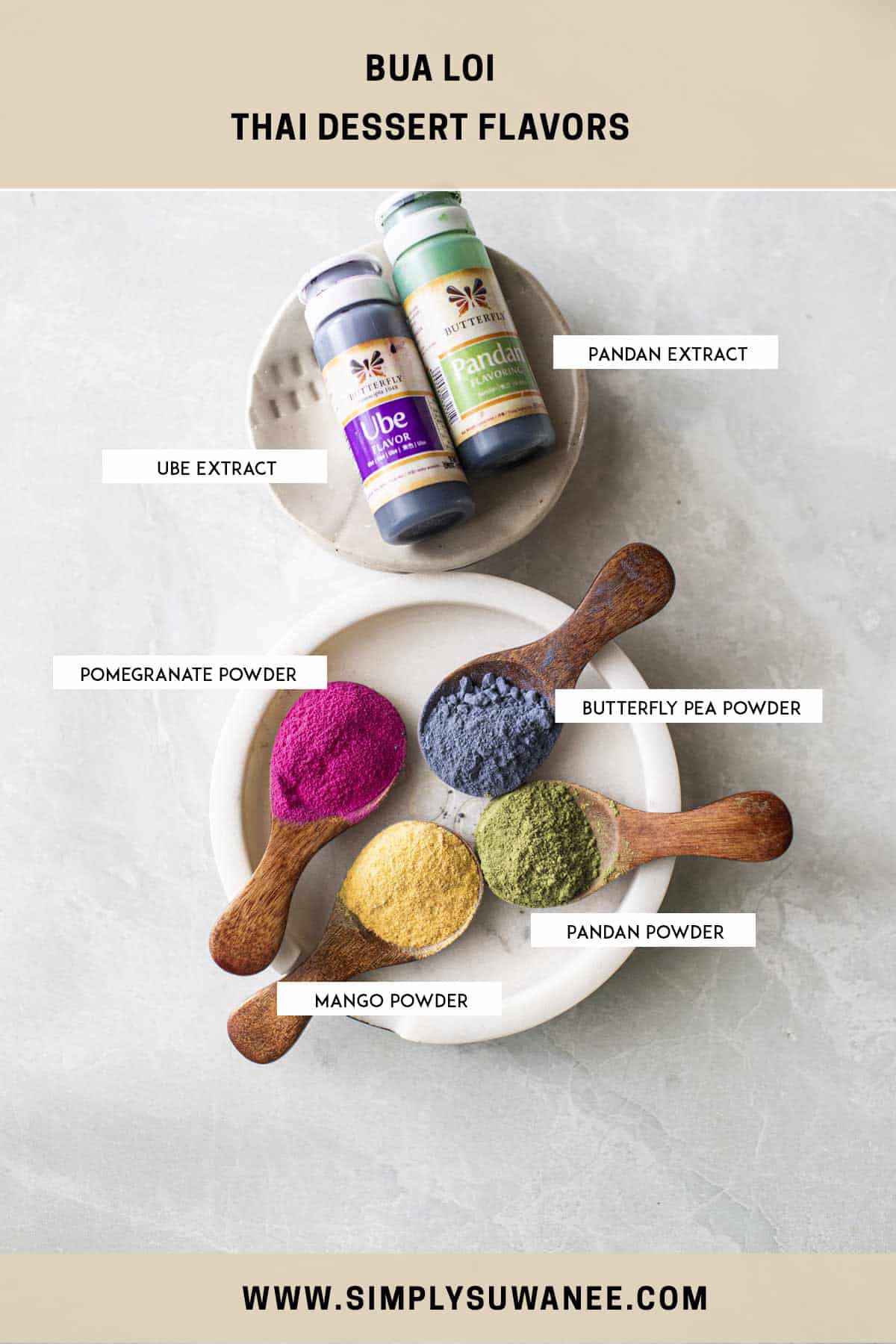
These are my favorite natural ingredients I use for my Bua loi desserts. You can use regular food colorings to brighten each color as well.
- Ube extract for the purple color.
- Pandan extract for the deep green coloring.
- Pomegranate powder for the red or pink color.
- Mango powder for the yellow color.
- Pandan powder and pandan extract for the green color.
- Butterfly pea flower for the blue color.
Starchy Vegetables for Making Bou Loi

1. Japanese purple potatoes - these give a lovely purple color to your dish. They are starchy, so use less flour and more water when making the dough.
2. Sweet potato or Jam - for a natural orange hue. They have a similar texture to purple sweet potatoes.
3. White or orange sweet potatoes - they can be used in a variety of colors. I prefer the white Japanese potato as it can easily be colored.
4. Taro - great for a neutral white color. It's tough to work with, but experiment with it and see what works best for you!
5. Kabocha squash - for a vibrant yellow color. Use only the bright, meaty part of this Asian pumpkin. See image below
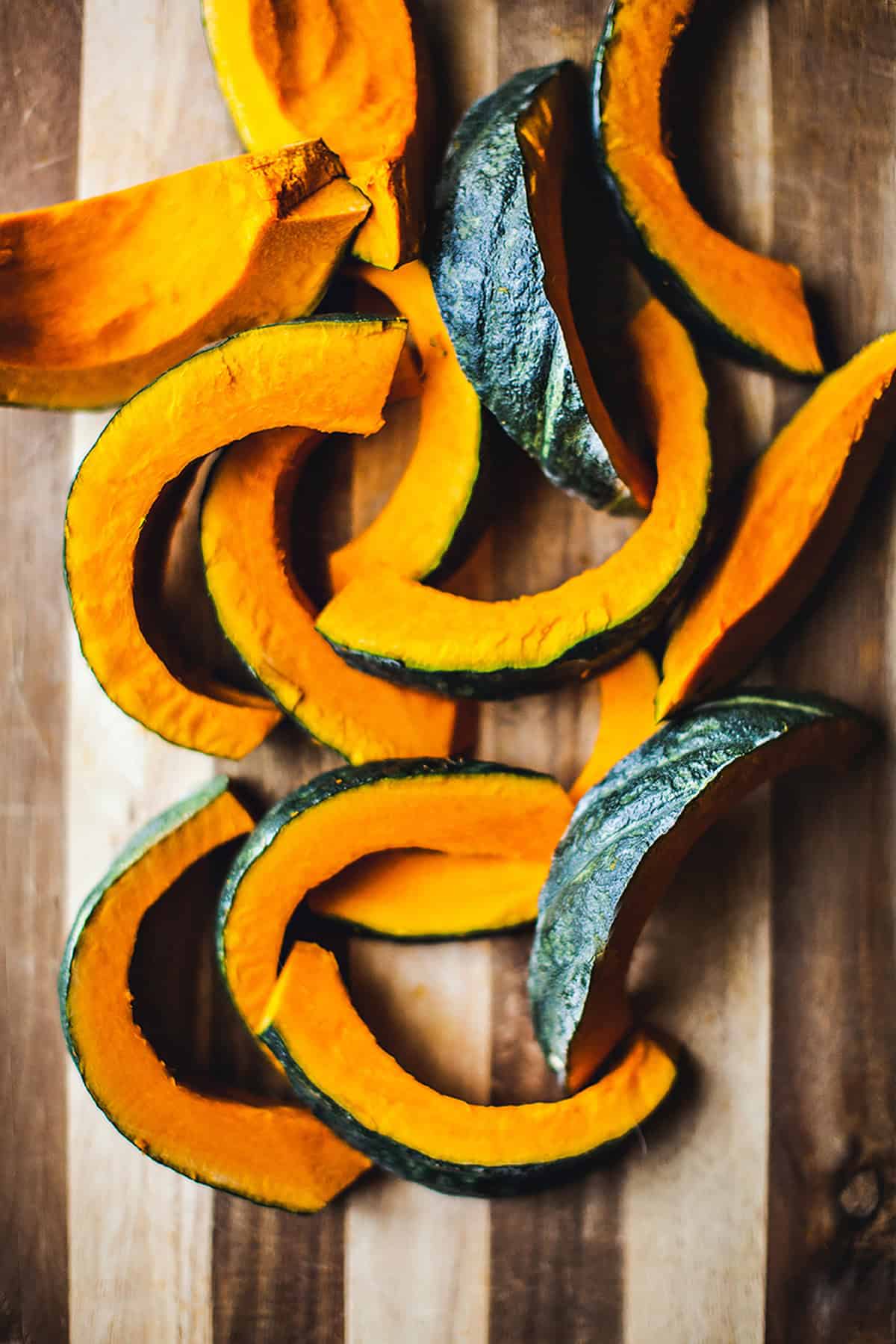
Experiment with different starchy vegetables to find your favorite for making this fun dessert.
Key Points to Remember About Bou Loi
- The starch used in the recipe may vary in consistency, making it hard to provide exact measurements. This recipe will teach you to cook like a Thai, where measuring cups and spoons are not commonly used.
- Thai cooking involves using your senses to gauge ingredients, such as watching, touching, smelling, and observing. Each ingredient is valued for its unique qualities, freshness, and seasonality.
- Growing up, I learned to cook without using measuring cups by watching the women in my village. It wasn't until I came to the US that I learned about them.
- For beginners, start with a white starch vegetable like white Japanese sweet potatoes. They have less starch, steam quickly, and are easy to mold. You can also use food coloring to create colorful Bou Loi. Once you feel comfortable, try experimenting with other starchy vegetables like purple potatoes, yams, taro, or kabocha squash.
How to Make Bua Loy
1. Clean your vegetables by peeling the skin, rinsing, patting them dry, and then cutting them into 1-inch pieces. Steam in hot water for 13-15 minutes or until soft.

2. Mash the steamed starch into a mashed potato consistency in a mixing bowl. Then, add your favorite food coloring or natural food powder. See the list of natural food colors above.
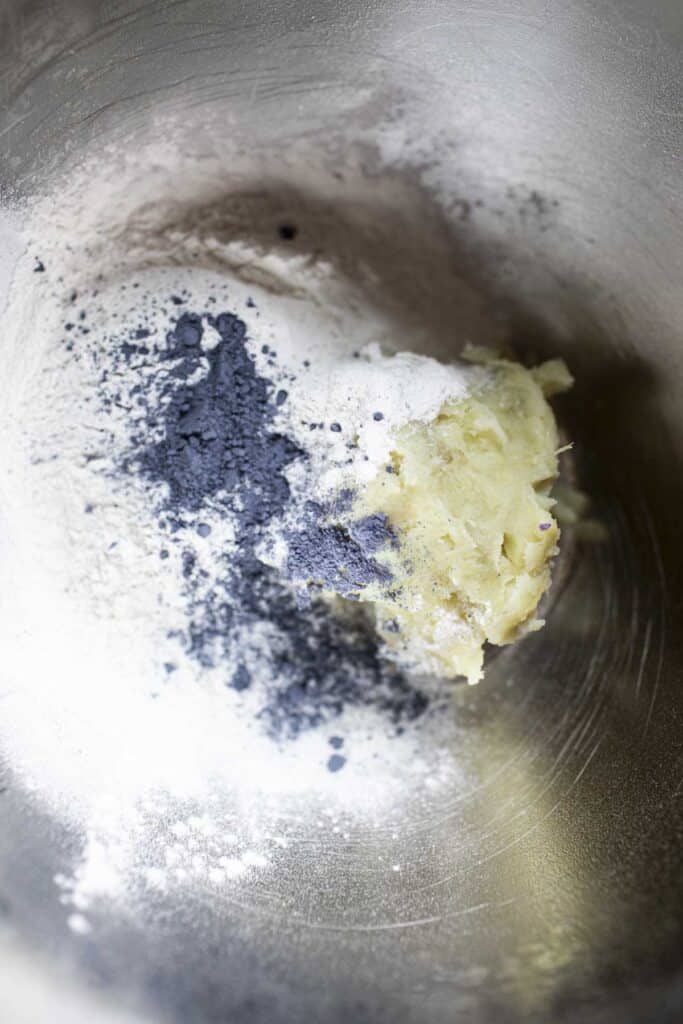
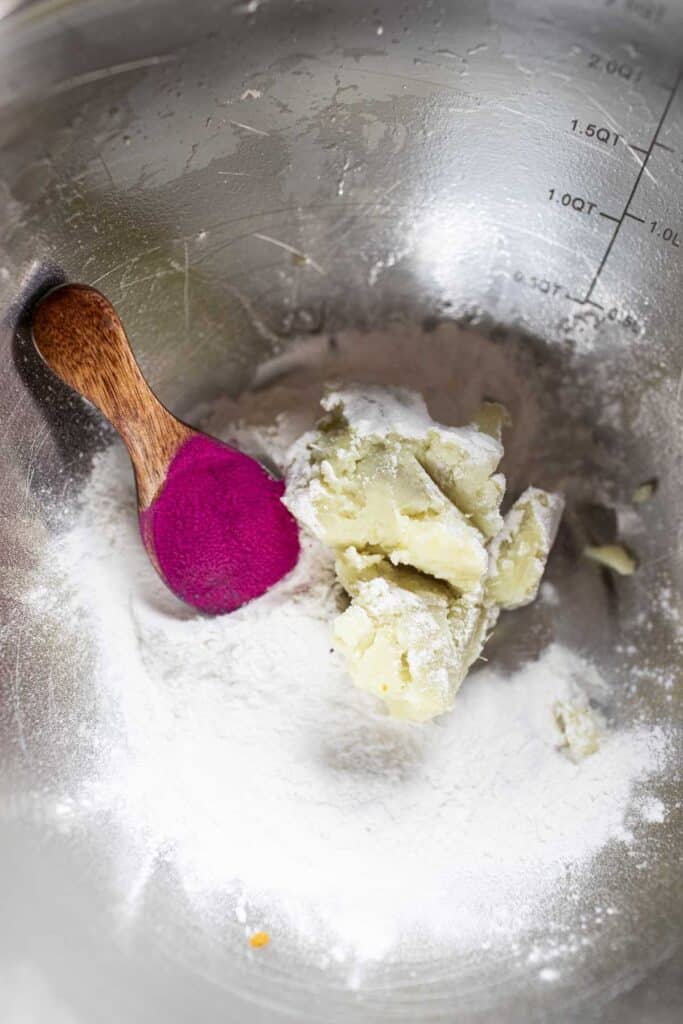
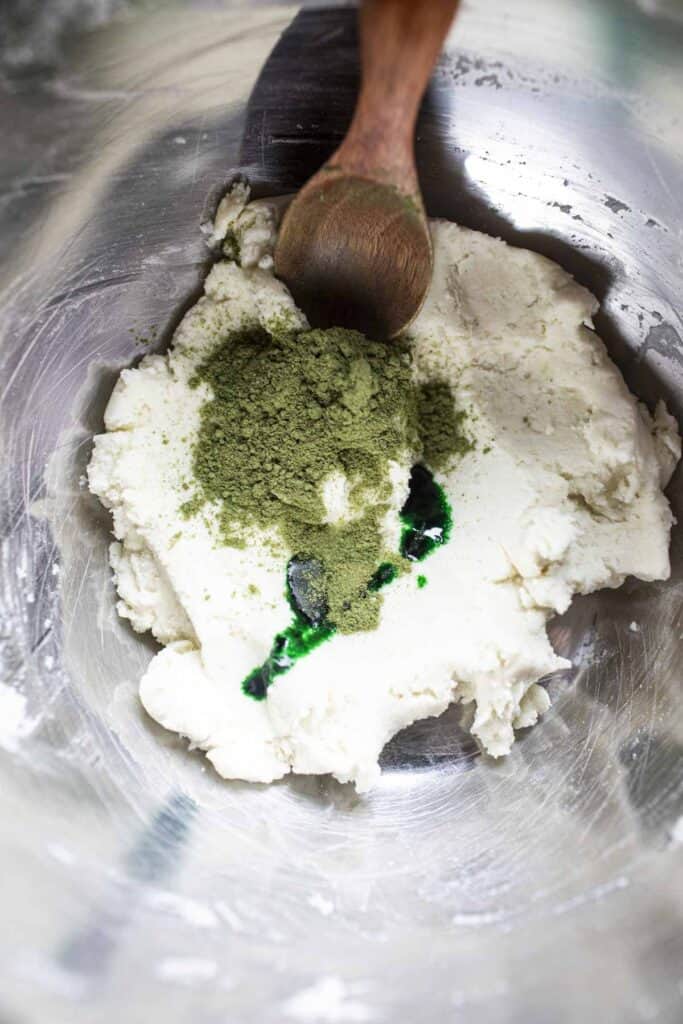

3. Add the sticky rice flour to the mashed vegetables. Slowly add water and your fingers to knead the dough together until a soft dough forms.
Each starch will require a little bit more or less of the flour and water. Adjust as needed until you have a soft dough like a play dough consistency.

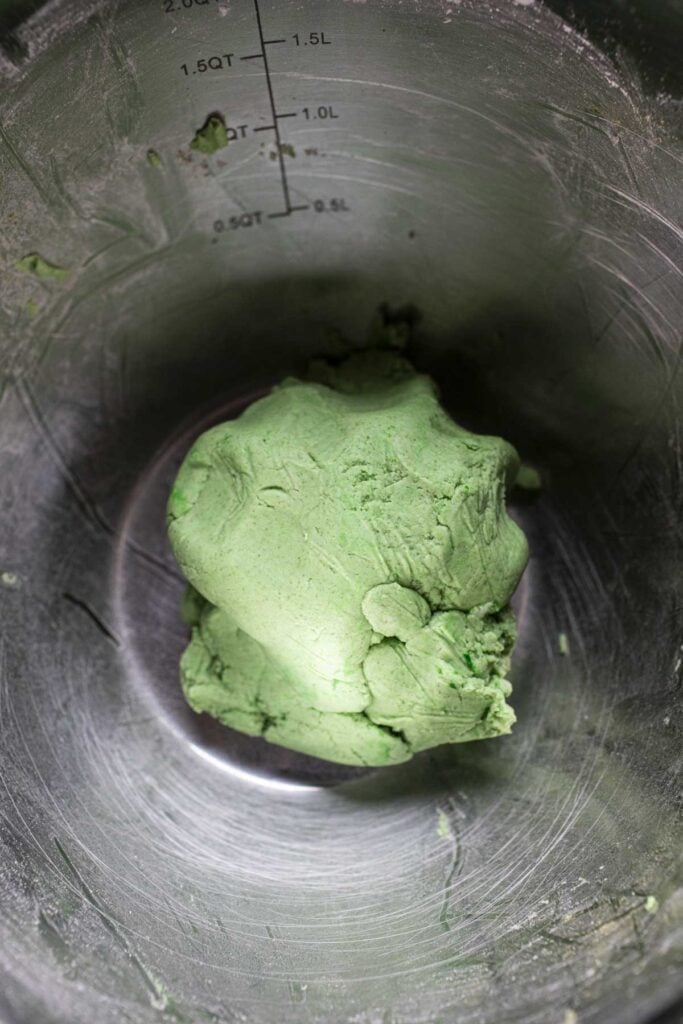
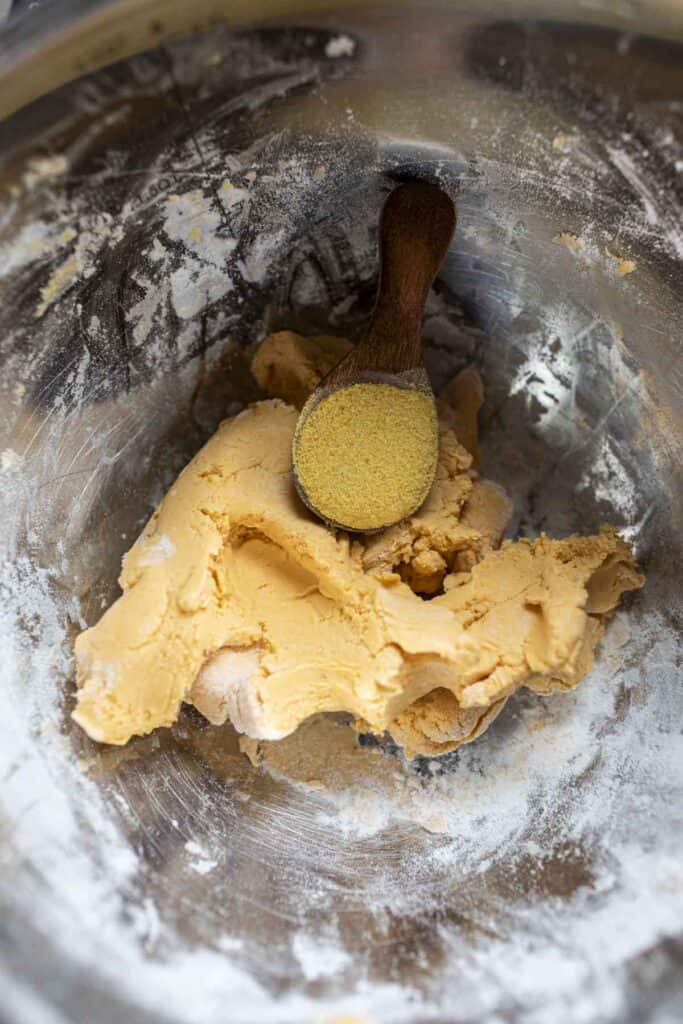
If using different vegetables instead of rice flour, cover the other dough with plastic wrap until ready to roll to keep it from drying.
4. Roll the dough into small balls in your palms, then use your fingertips to help form a perfect round, tiny ball!
Place them on a flat surface with a light coat of flour to prevent the dough balls from sticking together. A large cutting board works well for this step, too.
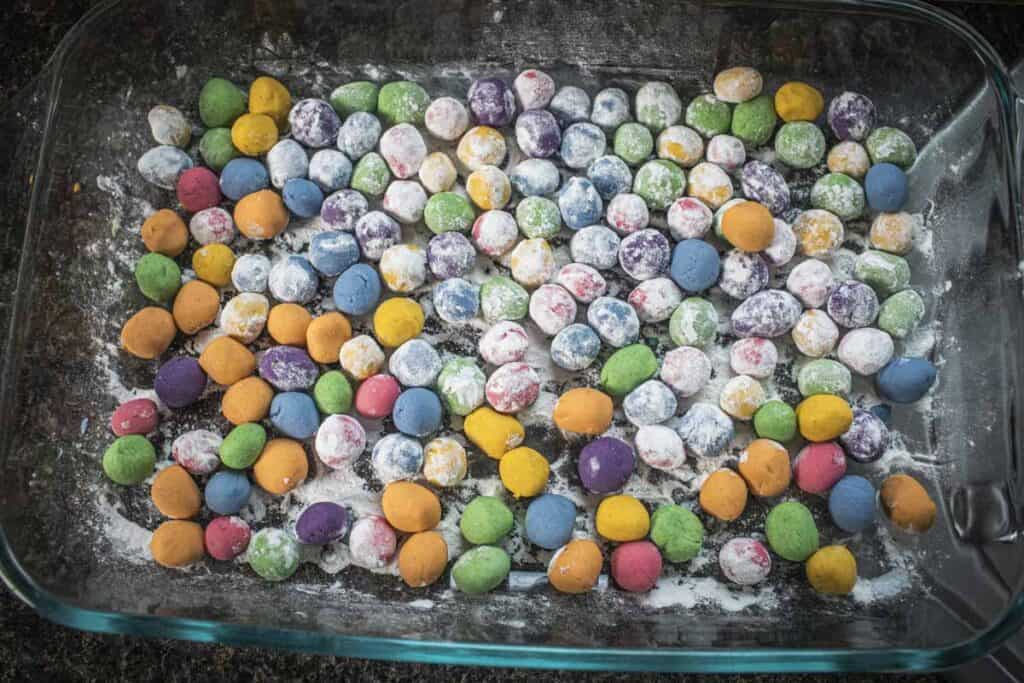
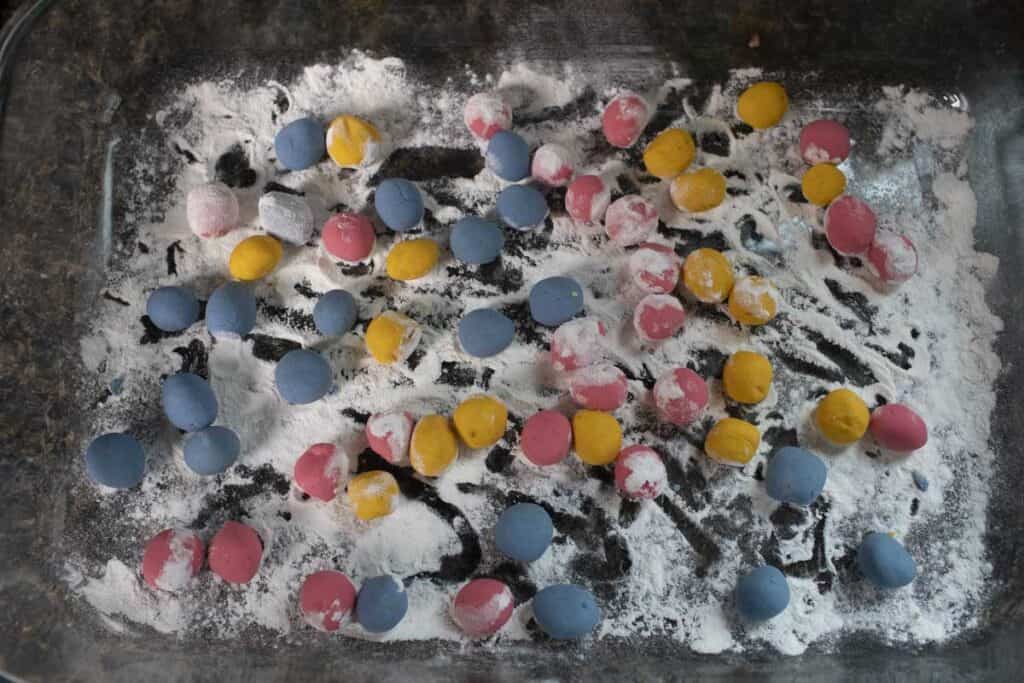

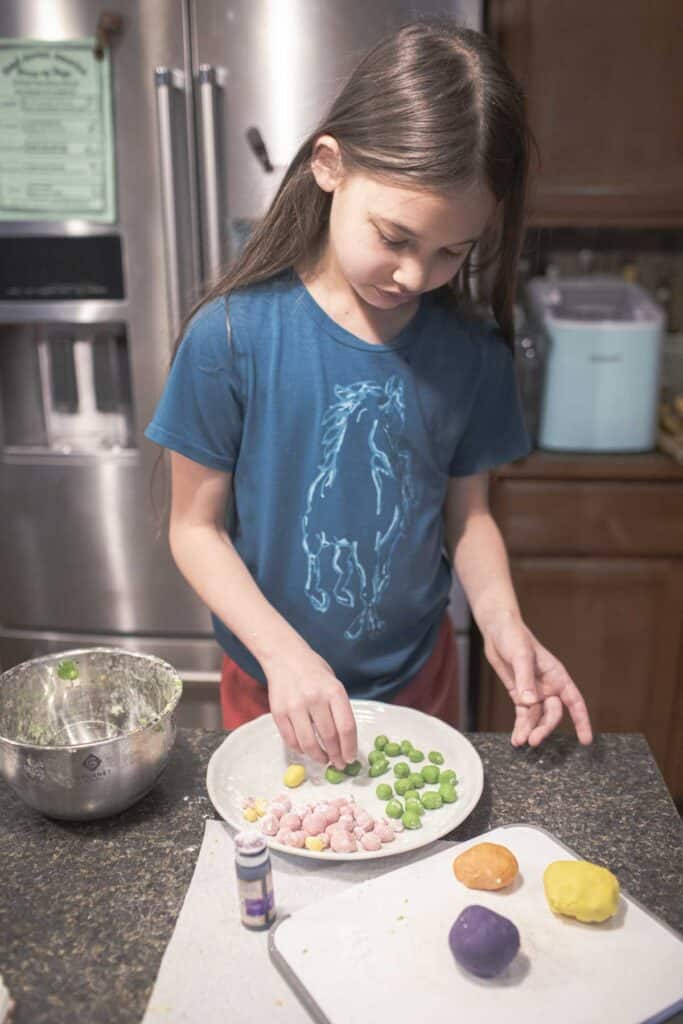
5. In a large pot of water, bring water to a boil. Slowly add the rice balls to the boiling water and cook for a couple of minutes until they float to the surface.
It only takes 1-2 minutes to cook the rice balls, so have a slotted spoon and ice bath ready.
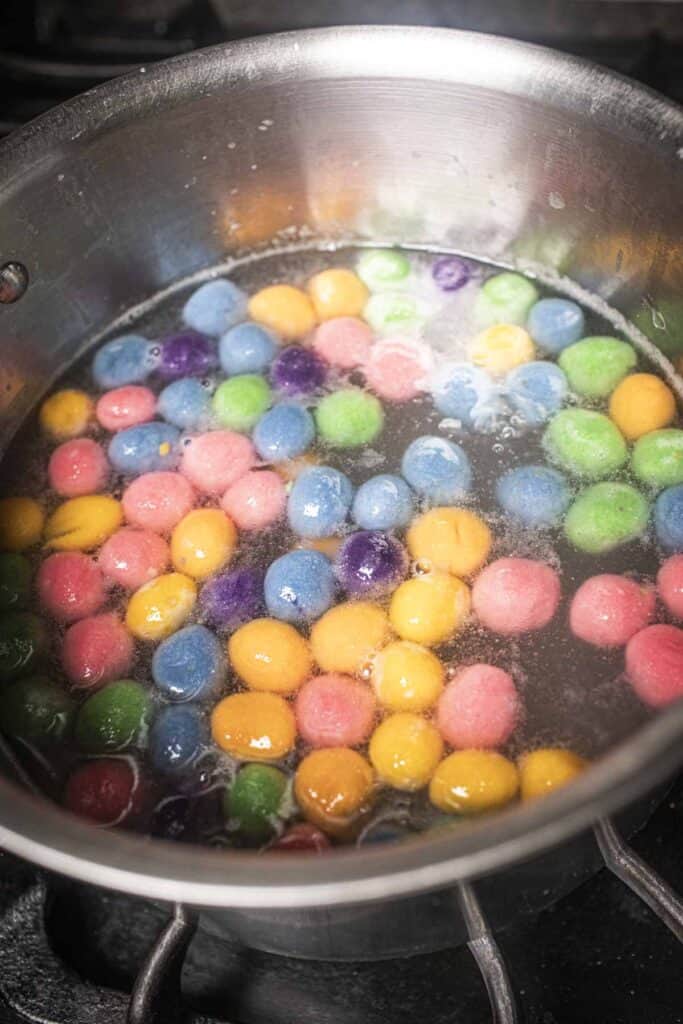
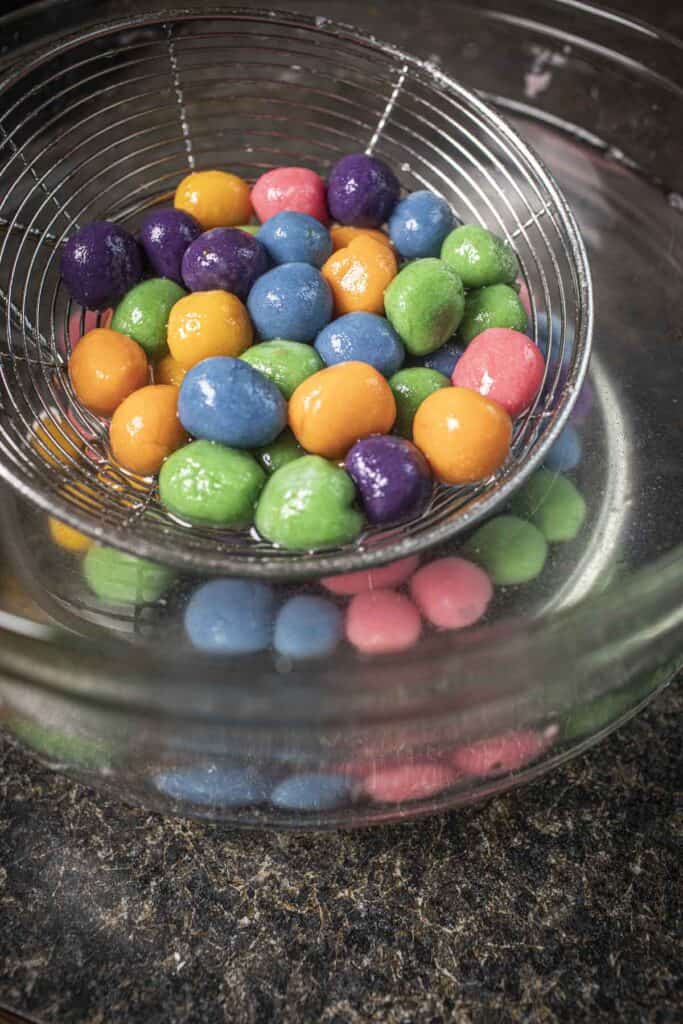
6. Remove the cooked balls from the hot water with a slotted spoon and place them in a large bowl of cold water to prevent sticking. Keep working until the balls are all cooked.
7. In a separate small saucepan, on medium heat, heat coconut milk with sugar and pandan leaves until the sugar dissolves. Let it simmer on the low heat while cooking the rice balls.
Remove the pandan leaves before serving.
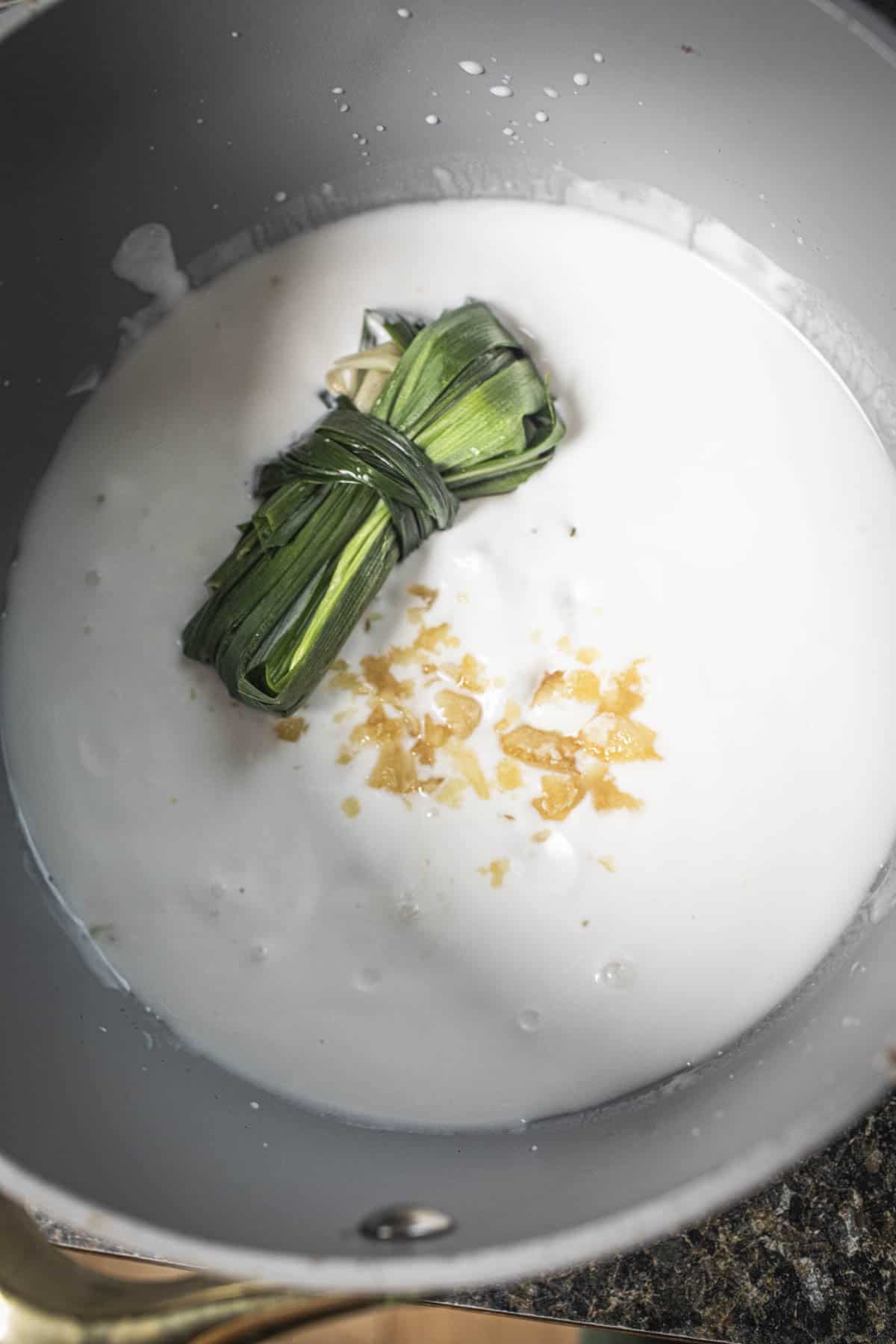
8. Add the colorful balls into the pot with the coconut milk, and let it soak in the flavors while you prepare a bowl or two for serving.
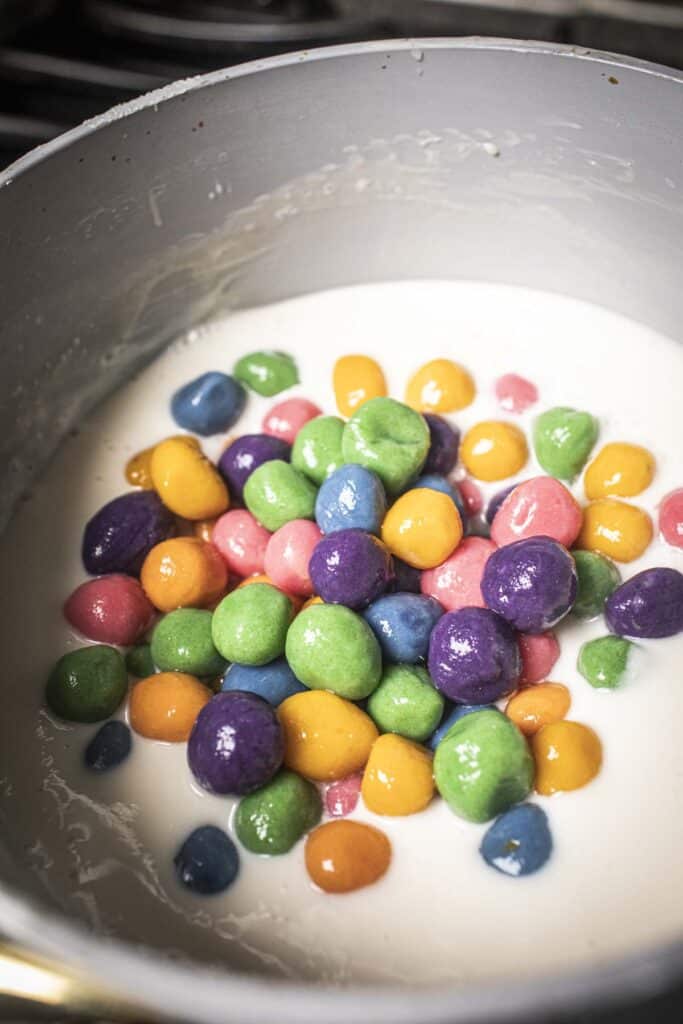

9. Now, the final step. Serve the cooked rice balls in coconut milk sauce.
How to Serve Bua Loy
- Enjoy warm as a comforting dessert on chilly evenings.
- Serve chilled at room temperature for a refreshing treat on hot summer days.
- Pair with a cup of sweetened coconut milk for an indulgent dessert experience.
- Garnish with butterfly pea flowers or other edible flowers for an elegant presentation.
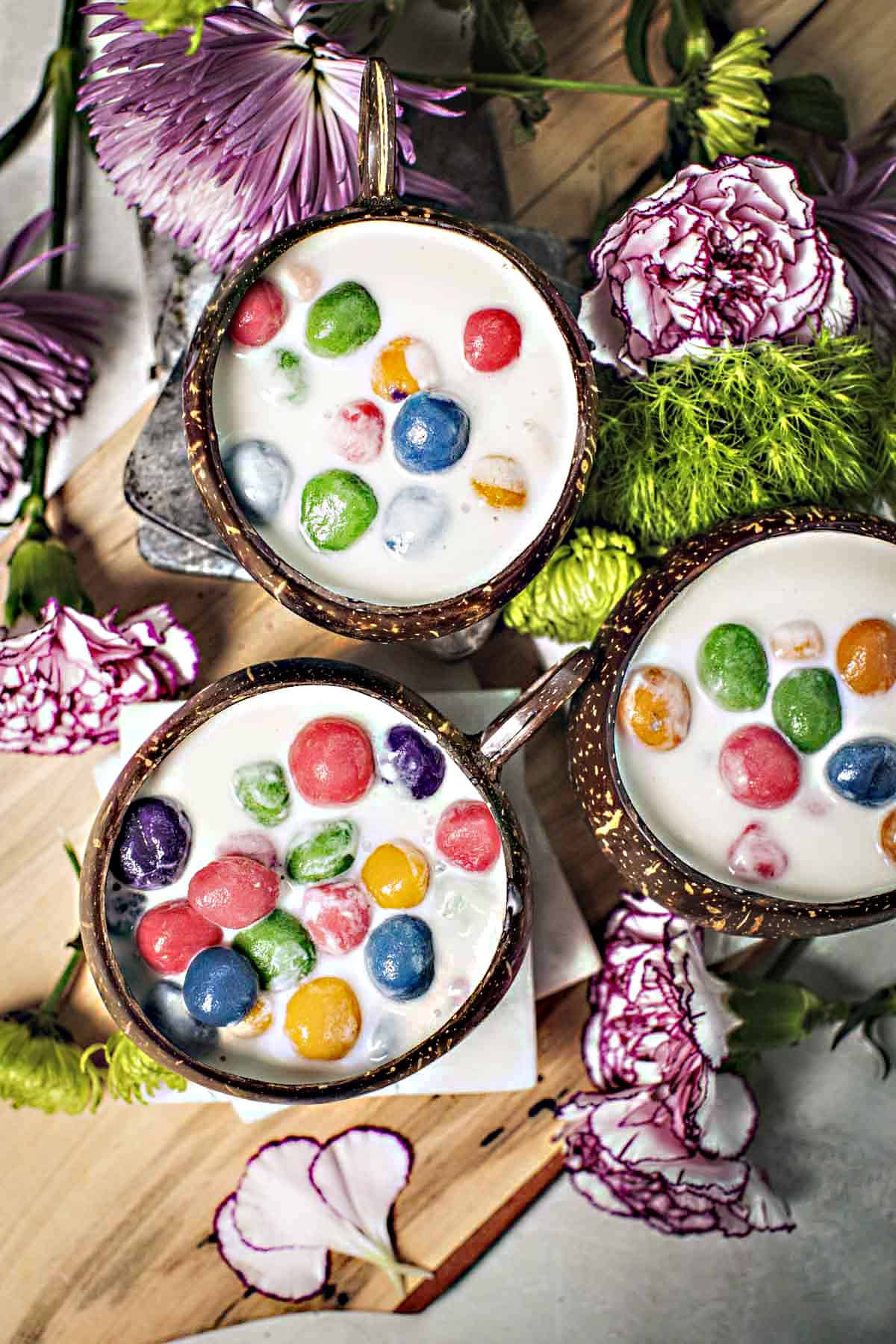
Tips for the Perfect Thai Dessert
- The amount of water used for each starchy vegetable will be different as each has a different level of starchiness and water content. Gradually add the water to the flour until you have a pliable dough but not so soft that your dough will not hold when boiling.
- Mix and match your starch as desired. Make pumpkin balls with kabocha squash or p mashed taro for your boa loi recipes.
- Adjust the size of the dough as preferred. Traditionally, Bua Loi is made with little balls. Mine is a bit bigger than normal but my kids love the large texture and it works great for us. Make your into smaller pieces if desired.
- If it's your first time making Bou loy dessert, I suggest picking one veggie to help simplify the process. Once you get a hang of it, add 1 or two more and play around with different combinations.
Variations & Substitutes
- Use pandan water instead of water for the green color Bua Loi balls for added flavors and color.
- Substitute palm sugar or brown for granulated sugar for a different flavor profile.
Storage
- Bua Loi is best served within the day of making it. Leftovers are not great as the rice balls will expand and aren't as fresh for dessert.
- However, you can store uncooked rice balls for 2 days in airtight containers in the refrigerator and prepare them fresh for serving with coconut milk sauce.

Other Thai Recipes
- What is Pandan and How to Use It
- Tom Yum Soup
- Thai Tea Boba (2 Ways-French Press and Stovetop)
- Different Types of Rice in Thai Cooking
- Easy Pandan Rice (with Thai Jasmine Rice)
Frequently Asked Questions
You can! Sure! You can use coconut cream instead of coconut milk. It's thick and rich, adding extra creaminess to your dessert. If you want a lighter sauce, mix in a bit of water.
While it does contain sugar for sweetness, using healthy vegetables makes it a better dessert option. Serve these in small portions and enjoy them in moderation.
Yes, there are! Some include egg yolks. Others add mashed taro, squash, or sweet potatoes. And then there's the simple version with just flour and no veggies. Enjoy experimenting with different variations!
I have never tried it, but I don't see why not. Give it a try, and you might have a pleasant surprise.
**Love a recipe you've tried? Please leave a 5-star rating in the recipe card below and a review in the comments section further down the page. Or follow me on Facebook, Pinterest, or Instagram!**
Print
Bua Loy Thai Glutinous Rice Balls
- Total Time: 30 minut
- Yield: 4 servings
- Diet: Gluten Free
Description
Get ready to delight your taste buds with the delightful flavors of Bua Loy Thai glutinous rice balls! This classic Thai dessert is a favorite among locals and tourists, offering a perfect blend of sweetness and chewy texture.
Ingredients
The Starchy Vegetables
- 7-8 ounces (½ pound) sweet potato, yam, taro, kabocha squash, purple potatoes, or a combination of your favorites.
- 1 cup glutinous white flour, more as needed
- ⅓ cup water, more or less as needed
The Coconut sauce
- 1 can of coconut milk 13.5 ounces
- ¾ cup sugar
- ¼ teaspoon salt
- 3 pandan leaves
Use these as a guideline. Make sure your dough is soft like a play dough where you can easily roll them into small balls without breaking. If they are too dry, add a touch of water to moisten. If it is too soft, add a sprinkle of flour to thicken it. Use your best judgment, and you're good if you can roll them easily into little balls!
For the white sweet potatoes
¼ cup mashed white sweet potato
2 tablespoons sticky rice flour (add more as needed)
2 teaspoons water (add more as needed)
For the taro
¼ cup mashed taro
1 ½ tablespoos sticky rice flour (add more as needed)
1 tablespoon water (add more as needed)
For the purple sweet potatoes, yam, orange-skinned sweet potato, and kabocha squash
¼ cup mashed veggies above
2 tablespoons sticky rice flour (add more as needed)
1.5 tablespoons water (add more as needed)
Instructions
1. Clean your vegetables by peeling the skin, rinsing, patting them dry, and then cutting them into 1-inch pieces. Steam in hot water for 13-15 minutes or until soft.
2. Mash the steamed starch into a mashed potato consistency in a mixing bowl. Then, add your favorite food coloring or natural food powder. See the list of natural food colors above.
3. Add the sticky rice flour to the mashed vegetables. Slowly add water and your fingers to knead the dough together until a soft dough forms. Each starch will require a little bit more or less of the flour and water. Adjust as needed until you have a soft dough-like play dough consistency. If using different vegetables instead of rice flour, cover the other dough with plastic wrap until ready to roll to keep it from drying.
4. Roll the dough into small balls in your palms, then use your fingertips to help form a perfect round, tiny ball! Place them on a flat surface with a light coat of flour to prevent the dough balls from sticking together. A large cutting board works well for this step, too.
5. In a large pot of water, bring water to a boil. Slowly add the rice balls to the boiling water and cook for a couple of minutes until they float to the surface. It only takes 1-2 minutes to cook the rice balls, so have a slotted spoon and ice bath ready.
6. Remove the cooked balls from the hot water with a slotted spoon and place them in a large bowl of cold water to prevent sticking. Keep working until the balls are all cooked.
7. In a separate small saucepan, on medium heat, heat coconut milk with sugar and pandan leaves until the sugar dissolves. Let it simmer on the low heat while cooking the rice balls. Remove the pandan leaves before serving.
8. Add the colorful balls into the pot with the coconut milk, and let it soak in the flavors while you prepare a bowl or two for serving.
9. Now, the final step. Serve the cooked rice balls in coconut milk sauce.
Notes
- The amount of water used for each starchy vegetable will be different as each has a different level of starchiness and water content. Gradually add the water to the flour until you have a pliable dough but not so soft that your dough will not hold when boiling.
- Mix and match your starch as desired. Make pumpkin balls with kabocha squash or p mashed taro for your boa loi recipes.
- Adjust the size of the dough as preferred. Traditionally, Bua Loi is made with little balls. Mine is a bit bigger than normal but my kids love the large texture and it works great for us. Make your into smaller pieces if desired.
- If it's your first time making Bou loy dessert, I suggest picking one veggie to help simplify the process. Once you get a hang of it, add 1 or two more and play around with different combinations.
- Prep Time: 20
- Cook Time: 10
- Category: desserts
- Method: stovetop
- Cuisine: Thai
** Thank you so much for visiting my blog! This is truly a passion for me. If you have enjoyed these recipes and appreciate the hard work I put into them, I would love it if you would share them with your friends! Your recommendation is the highest review I could hope for, and I’d appreciate it! **
More Thai Dessert Recipes
Looking for other recipes like this? Try these delicious and authentic Thai desserts!



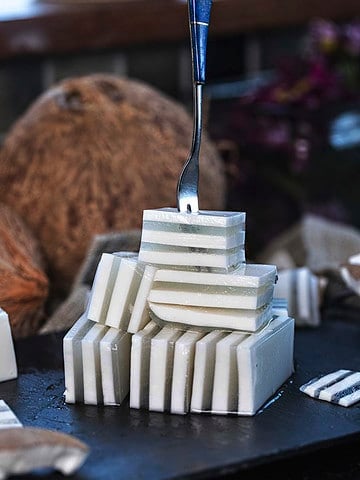
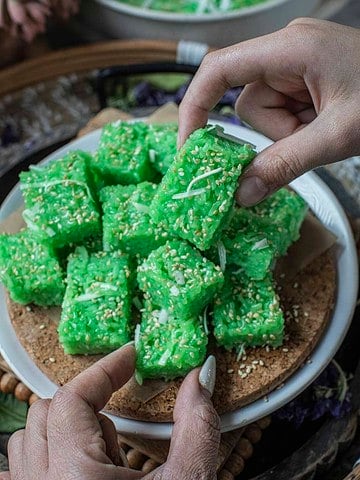

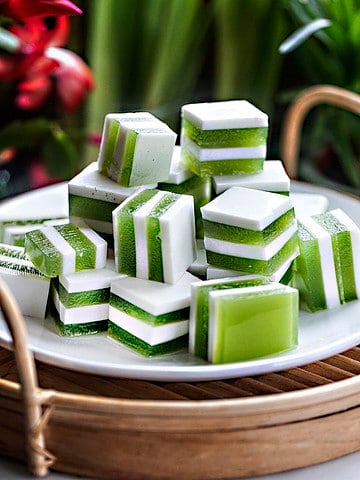


Leave a Reply